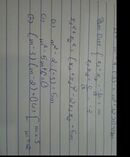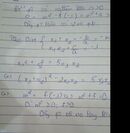
Hãy nhập câu hỏi của bạn vào đây, nếu là tài khoản VIP, bạn sẽ được ưu tiên trả lời.


a) Thay m = 3 vào đẳng thức đó ta có:
x2 - 6x + 4 = 0
\(\Leftrightarrow\) (x - 3)2 - 5 = 0
\(\Leftrightarrow\) (x - 3)2 = 5
\(\Leftrightarrow\) \(\orbr{\begin{cases}x-3=\sqrt{5}\\x-3=-\sqrt{5}\end{cases}}\)
\(\Leftrightarrow\) \(\orbr{\begin{cases}x=\sqrt{5}+3\\x=3-\sqrt{5}\end{cases}}\)

Ta có: \(\Delta=\left(-m\right)^2+4.3=m^2+12>0\)
=> pt luôn có 2 nghiệm phân biệt
Theo hệ thức vi-et, ta có: \(\hept{\begin{cases}x_1+x_2=m\\x_1x_2=-3\end{cases}}\)
Theo bài ra, ta có: x12 + x22 = 5m
<=> (x1 + x2)2 - 2x1x2 = 5m
<=> m2 + 6 = 5m
<=> x2 - 5m + 6 = 0
<=> x2 - 2m - 3m + 6 = 0
<=> (m - 2)(m - 3)= 0
<=> \(\orbr{\begin{cases}m=2\\m=3\end{cases}}\)

a, Để phương trình có 2 nghiệm phân biệt thì
\(\Delta>0< =>\left(-2m\right)^2-4.\left(2m^2-1\right)>0\)
\(< =>4m^2-8m^2+4>0\)
\(< =>-4m^2+4>0\)
\(< =>m< 1\)
b, bạn dùng viet và phân tích 1 xíu là ok
Ta có : \(x^2-2mx+2m^2-1=0\left(a=1;b=-2m;c=2m^2-1\right)\)
a, Để phương trình có 2 nghiệm phân biệt thì \(\Delta>0\)
\(\left(-2m\right)^2-4\left(2m^2-1\right)>0\)
\(\Leftrightarrow4m^2-8m^2+4>0\Leftrightarrow-4m^2+4>0\)
\(\Leftrightarrow-4m^2>-4\Leftrightarrow m< 1\)
b, Theo hệ thức Vi et ta có : \(\hept{\begin{cases}S=x_1+x_2=\frac{-b}{a}=\frac{2m}{1}=2m\\P=x_1x_2=\frac{c}{a}=\frac{2m^2-1}{1}=2m^2-1\end{cases}}\)
Ta có : \(x_1^3-x_1^2+x_2^3-x_2^2=2\)
Ta có thể viết là : \(x_1^3+x_2^3-\left(x_1^2+x_2^2\right)=2\)tương tự vs \(x_1^3+x_2^3-\left(x_1+x_2\right)^2=2\)
\(\Leftrightarrow x_1^3+x_2^3-\left(2m\right)^2=2\Leftrightarrow x_1^3+x_2^3-4m^2=2\)(*)
Phân tích nốt : cái \(x_1^3+x_2^3\)tớ ko biết phân tích thế nào, lm chỉ sợ sai

Bạn tham khảo nhé !
x2 + mx - 1 = 0 có Δ= m2 - 4 ( x - 1 ) = m2 + 4 \(\ge\)0 \(\forall\)x \(\in\)R \(\Rightarrow\)phương trình luôn có 2 nghiệm phân biệt
Theo định lý Viete, ta có: \(\hept{\begin{cases}x_1+x_2=-m\\x_1x_2=-1\end{cases}}\)
Theo giả thiết: x21 + x22 = 5x1x2 \(\Leftrightarrow\)( x1 + x2 ) 2 = 7x1x2
\(\Rightarrow\)( - m ) 2 = 7 ( - 1 ) \(\Rightarrow\)m2 = - 7 \(\Leftrightarrow\)m \(\in\)\(\varnothing\)
Vậy không tồn tại m thõa ycbt

